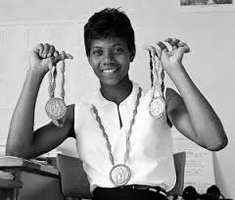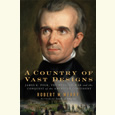The Many Meanings of Wilma Rudolph
In (Re)Presenting Wilma Rudolph, Rita Liberti and Maureen Smith prod us to consider how we remember our sports heroes
In (Re)Presenting Wilma Rudolph, historians Rita Liberti and Maureen Smith point out that Wilma Rudolph is the subject of at least twenty-one different children’s books. Twenty-one! It might seem like overkill, but then again this story is almost fantastic, like a tale plucked from a cheesy television movie. Rudolph grew up poor and black in the Jim Crow South, survived polio but wore a heavy leg brace in childhood, and overcame it all to win three gold medals at the 1960 Olympic Games. It is a rags-to-riches, pull-yourself-up-by-the-bootstraps tale, an American myth writ large.
 Yet Rudolph has never been the subject of an “adult” biography—a surprising omission, given her historical importance. While still at Burt High School in Clarksville, Tennessee, she won a bronze medal at the 1956 Melbourne Olympics. Four years later, after bolstering the track-and-field dynasty at Tennessee State University, she went to Rome and won the 100-meter dash, 200-meter dash, and 400-meter relay, becoming a symbol of American democracy at the height of the Cold War. Her athletic prowess and graceful beauty helped make women’s events a mainstay of domestic track-and-field competitions. She also participated in the civil-rights movement, both as an icon and an activist. Finally, at the dawn of the modern women’s movement, she laid bare her personal struggle to balance conflicting desires—to be a conventional homemaker and also to engage a broader public.
Yet Rudolph has never been the subject of an “adult” biography—a surprising omission, given her historical importance. While still at Burt High School in Clarksville, Tennessee, she won a bronze medal at the 1956 Melbourne Olympics. Four years later, after bolstering the track-and-field dynasty at Tennessee State University, she went to Rome and won the 100-meter dash, 200-meter dash, and 400-meter relay, becoming a symbol of American democracy at the height of the Cold War. Her athletic prowess and graceful beauty helped make women’s events a mainstay of domestic track-and-field competitions. She also participated in the civil-rights movement, both as an icon and an activist. Finally, at the dawn of the modern women’s movement, she laid bare her personal struggle to balance conflicting desires—to be a conventional homemaker and also to engage a broader public.
(Re)Presenting Wilma Rudolph is not the biography to fill this void. In fact, Liberti and Smith seek to disrupt the very idea of an authoritative account of any life. “What ‘really’ happened within and across various episodes of Wilma Rudolph’s life is less of our concern in this book,” they write. “Rather, we are more interested in interrogating why certain stories and remembrances of Rudolph remain center-stage, while others have far less purchase, and are forgotten.” They offer critical perspectives on the depictions of Rudolph’s life and career, both during and after her heyday.
After Rudolph’s Olympic triumphs, Clarksville’s civic leaders held a homecoming celebration that included a parade through town and a huge banquet attended by blacks and whites alike. The authors argue that although the event was truly an historic occasion, it also allowed white leaders to smooth over the city’s racial inequalities and permitted a misrepresentative narrative to emerge in the national media—magazines such as Life reported a county judge’s declaration that “to get the best music out of a piano one had to play both black and white keys.” Years later, a story emerged that Rudolph had refused to participate in the celebration unless it was racially integrated. Is the tale true? Liberti and Smith do not answer that question. The story’s existence, however, suggests that African Americans had begun to challenge the narrative of generous white leaders who graciously endorsed the spirit of racial cooperation.
PRESENTING WILMA RUDOLPH_1.jpg) The depiction of Rudolph as a feminine beauty had political implications, as well. The press described her as a “young lady of charm and poise,” “willowy,” “café au lait,” and the “very embodiment of black grace, a beautiful, flowing, lissome sight as she bounded over the track.” Rudolph herself carefully adhered to gender norms: she refused to race against men, and after one victory she asked a friend for a mirror and comb before appearing on the medal stand. The authors place Rudolph within the black “politics of respectability” which used style and restraint to win respect across racial lines.
The depiction of Rudolph as a feminine beauty had political implications, as well. The press described her as a “young lady of charm and poise,” “willowy,” “café au lait,” and the “very embodiment of black grace, a beautiful, flowing, lissome sight as she bounded over the track.” Rudolph herself carefully adhered to gender norms: she refused to race against men, and after one victory she asked a friend for a mirror and comb before appearing on the medal stand. The authors place Rudolph within the black “politics of respectability” which used style and restraint to win respect across racial lines.
On both sides of the Iron Curtain, Olympic medals served as symbols of national superiority, and Rudolph was used as a weapon in the cultural Cold War. After her triple triumph in Rome, the United States Information Agency produced a ten-minute documentary film titled Wilma Rudolph: Olympic Champion that highlighted Rudolph as a hardworking, church-attending college student. In 1963, American officials sent her on a month-long goodwill tour of African nations. Yet as Liberti and Smith point out, such tours could also sharpen the political consciousness of black athletes. One month after her return from Africa, Rudolph participated in the protest of a segregated Shoney’s restaurant in Clarksville.
Interestingly, Rudolph downplayed her civil-rights activism in her 1977 autobiography, Wilma: The Story of Wilma Rudolph. Even though she described the difficulties of life under segregation and expressed racial pride, she avoided any mention of the demonstration at Shoney’s. According to Liberti and Smith, Rudolph instead envisioned her own body as the real “site of repression,” focusing on the way she overcame both her childhood disability and a teenage pregnancy. But she also addressed her challenges at the intersection of race and gender, regretting her limited opportunities to capitalize on her celebrity after the Olympics.
The final chapters in (Re)Presenting Wilma Rudolph address the various ways in which Rudolph is remembered, from television specials to children’s books to Clarksville’s public monuments. In each case, the authors argue, Rudolph’s meaning is rendered in conservative ways. The popular television biopic Wilma emphasizes her close-knit family and strong male authority figures, rather than Rudolph’s own influence on sports and civil rights. The children’s books pose disability as an individual hurdle to surmount: when Rudolph finally sheds her brace, these narratives suggest, she becomes “normal”—an implication that disabled people are abnormal. Clarksville moved a statue of Rudolph from a park to the riverfront to an event center, but as the authors write, “her statue was always on the edges of the city, as opposed to the city’s public square or main street, where numerous memorials to others reside.”
In the end, Liberti and Smith conclude that there are many meanings to Wilma Rudolph. But if we adhere to the dominant story of an individual extraordinary woman conquering hurdles of disability, poverty, racism, and sexism, we obscure the way Rudolph’s struggles reflect those of the wider society, both in the past and the present.

Aram Goudsouzian chairs the history department at the University of Memphis. His most recent book is Down to the Crossroads: Civil Rights, Black Power, and the Meredith March Against Fear.


